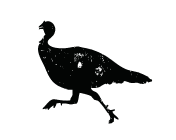Turning a small farm into a southern whitetail sanctuary takes planning and work, but the results are worth it
Proper land management is like a good marriage. The more you put into it, the more you get out of it. Improvements are slow to materialize, and best measured over time. It's a lot of work, but the rewards make it all worthwhile.
Habitat is a living, breathing thing. It was here before we were, and if we play our cards right, it'll be around long after we're gone. Until then, we'll manage it for big whitetails. Here's a look at how I accomplish this on my own property.

Setting the Stage
Fertile soils and an abundance of nuts, fruits, fish, shellfish, birds, small and large game animals make the crescent-shaped Black Belt region of Alabama rich with wildlife. This area stretches across the mid-section of the state from the Chattahoochee River all the way to Mississippi. It's dominated by well-drained soil with low, undulating hills.
My wife, Tes Jolly, and I began our land- and wildlife-manager journey here more than 15 years ago with the purchase of a small farm. The original farm had been in her family for some 20 years, but it was this abundance of wildlife and natural resources that attracted and inspired us to become caretakers of a small portion of it.
The land is my family, Tes says. My parents saw it that way and we see it that way as well. It's just an extension or part of us. We spend so much time on it that hunting is just a natural thing to do.
Throughout the years, this place has allowed us to connect with nature, each other and God. It's where we've worked, played, prayed and found happiness. For now, we're charged with nurturing, protecting and improving it for the next caretakers and the wild things that live on it. It requires most of our spare time (and all of our play money), but our happiness is bound to the land.
So, how did we get here?

A Blueprint for Management
When we took the reins, our No. 1 goal was to attract and grow mature whitetail bucks. The plan didn't come easily; rather, it evolved over time.
First, we decided how we would define mature bucks in our area, and estimated the odds of growing and holding them on a relatively small parcel. After much debate, we decided to adopt the formula for determining shooter bucks used by Tara Wildlife, one of the South's premier bowhunting destinations. We felt this approach would not only benefit our deer herd but also turkeys and small game.
Tara's track record has proven that most bucks fulfilling at least three of the following five standards are 3½ years old or older. Those standards include:
- A 15-inch-plus inside spread
- A minimum body weight of 185 pounds
- A main beam length of 18 inches or more
- Mass of 4 inches carried throughout the rack
- Good tine length
That model continues to produce big deer on our farm, and we can thank Tara's head guide, Bobby Culbertson, for the idea.
A management plan is extremely important, Culbertson says. A good management plan is based on data - years of research and record keeping. A good plan tells a hunter what he should and should not do, and by following those guidelines that hunter is contributing to the good of the deer herd.

Improving Habitat
Another pillar of the plan involves the landscape. The existing 60 acres of Bahiagrass pasture on our farm offered little to no benefit to deer or other wildlife. The other 155 acres consisted of hardwood ridges and draws, tupelo and oak swamp, and 25 acres of loblolly pine that had been planted in 1995. By 2000, these pines provided excellent bedding for deer.
The best habitat improvement we do for our deer is timber management, Culbertson says. We identify compartments of timber that do not offer good browse or mast production and select cut or clear cut that compartment. When we select cut, we target trees that do not produce mast and eliminate them. Clear-cut areas produce little, if any, mast. The idea is to get sunlight on the ground and let the natural seed bank regenerate. We have found these areas offer something for deer to eat year-round.
Food is crucial, too. Everybody has their magical formulas for planting deer food, and Culbertson is no exception.
We have found that clover is very beneficial, he says. Clover plots are hard to maintain but well worth the effort. The other thing is what I call the magic bullet. That is Aeschynomene, [or American jointvetch]. It is the one thing we can plant that deer cannot browse down. The more they browse it, the more it produces.
If you aren't able to or interested in planting, you can still provide food and cover. In 2001, we began converting pastureland into just that with fire and mowing techniques. By 2005, we planted an additional 20 acres of loblolly pine in two areas. We devoted four more acres of pasture to green fields, and 10 acres to corn. We planted eight remaining acres of old food plots in the fall with a standard green-field blend of cereal grain, clover and brassicas.

Render Time
Three fruitless seasons passed. Those were difficult years, since we were not seeing the immediate improvement in buck quality we expected. We monitored deer extensively with trail cameras without luck. Then, in 2008, everything changed. Right when it seemed our plan was failing, a mature velvet-antlered buck showed up. We named him Stickers, and our spirits soared. even though we never caught up to him. Another season ended, but we remained patient.
My best advice is to stay busy and start new projects, Tes says. As long as you have new projects and goals, time goes by faster and you always have something to look forward to.
By 2009, our plan finally began working. Trail cameras revealed mature bucks on the farm day and night. In November of that year, Tes shot the Island Buck - a 215-pound 8-pointer - with her muzzleloader. A month later, she shot a buck named Non-Typ. And to cap off an already-great season, she shot the buck we called Hoss in January. Non-Typ and Hoss each tipped the scales at 225 pounds, and all three bucks were at least 4 ½ years old.

Next Steps
After such a successful season, we adjusted our expectations of a shooter buck. We shifted our goals to harvesting 4½-year-old bucks and older. We adjusted some of our expectations to reflect what we thought represented that age class:
- A 16-inch-plus inside spread
- A minimum body weight of 200 pounds
- A main beam length of 20 inches or more
- Mass of 4 inches carried throughout the rack
- Good tine length
The formula we use to determine a shooter buck is an average of measurements taken from harvested deer over a period of years, Culbertson says. At Tara, over 90% of bucks that meet three of these [above] five requirements are 4½ years old. This formula gives hunters a good guideline for choosing to shoot or pass a buck.
Back on our farm in the summer of 2010, we discovered a bachelor group of four mature bucks. We named them Shorty, Lops, Oops and Flop. All were shooters, and we were on the right track. It was proof that our dirt could grow and hold mature bucks. In addition, the turkey population was improving, bobwhite quail returned, and rabbits and squirrels were abundant.
Set long-term goals like creating native areas for food and bedding areas, Tes advises. Manage timber by thinning and burning to unleash the natural seed bank. Change up your property by creating a sanctuary or new bedding areas and food sources.
That standard is the one we continue to operate by today. And we've taken many good bucks off the farm as a result.
The Takeaway
None of this is easy or casual work. When you buy or manage hunting land, it requires planning, thought and commitment. What you do today to improve land for wildlife often takes years to pay dividends for wildlife. So be patient. Land can often be changed with a single action, but improvement and the impact on wildlife is generational.
Don't Miss: 7 Best Food Plot Shapes for Bowhunting Whitetails
Check out more stories, videos and educational how-to's on land management.










































